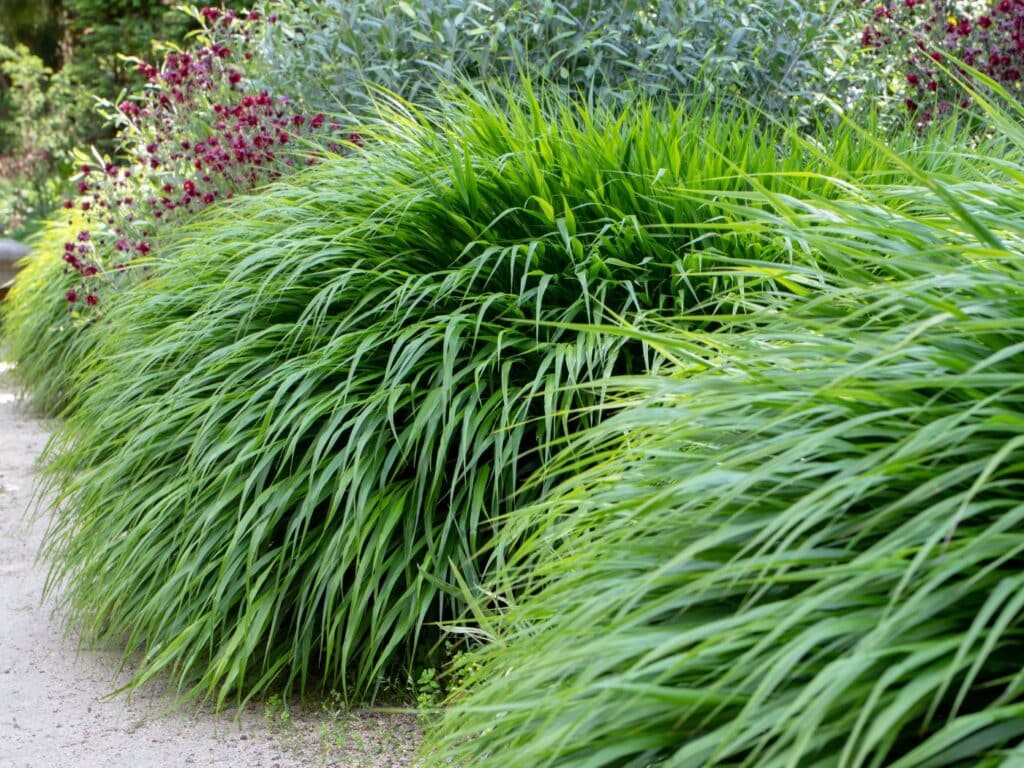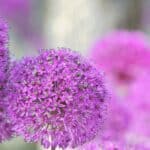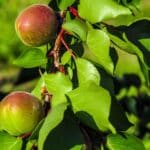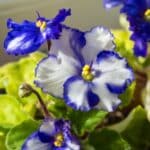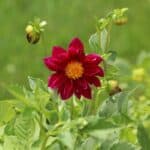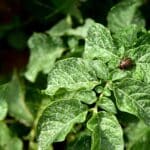Japanese forest grass (Hakkonechloa macra), also called Hakone grass, is one of the most popular shade-loving perennial grasses because it is one of the few varieties that can flourish in these low-light conditions.
These grassy plants produce flowers, but Japanese forest grass blooms are tiny, nondescript, and usually go unnoticed. Most people grow these deciduous ornamental grasses because they have dense foliage and long, bright green leaves that create a vivid fountain effect in a garden bed or container.
You can plant Japanese forest grass with companion plants to enhance their aesthetics or keep your garden full when the foliage starts to die back for winter.
This guide will explore some of the best plant species to pair with Hakone grass to create a striking garden.
What to Plant with Japanese Forest Grass
When choosing the best Hakone grass companion plants, it is always best to select species with similar growing conditions and a similar growing season.
Japanese forest grass grows its absolute best in humus-rich soil that drains well but is kept moist. Unlike most grasses, these perennials will wilt and die if they are exposed to too much sunlight. They should be planted in a shade garden but can survive in full sun if grown in colder regions.
Here is a look at some of the best plant combinations for this beautiful ornamental grass
Coral Bells
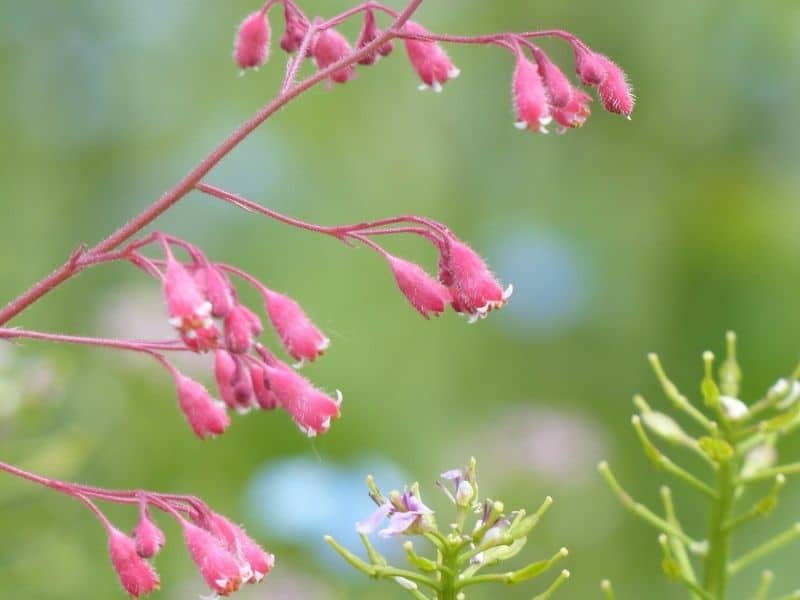
Gardeners prefer to combine Japanese forest grass with coral bells (Heuchera) because the foliage plant adds a lot of contrast to your garden bed, and the evergreen perennials maintain your garden full and healthy all year.
Coral bells are famous because their leaves are brightly colored. Different varieties have different colored leaves, including hues like green, chartreuse, yellow, peach, copper, purple, and many others.
This plant species will also grow well in the same shady spot as your Hakone grass because they prefer partial shade, and well-drained soil needs to be kept moist.
When pairing heuchera with Japanese forest grass, it is best to focus on varieties that starkly contrast the lime-green leaves of Hakone grass.
A good example is a combination of forest grass with the glossy purplish bronze leaves of palace purple heuchera. This combination of dark and light will create a striking effect in your garden.
It is also best to mass plant your heuchera all over your garden with the taller forest grass heads poking out here and there amongst these mass plantings.
Dwarf Ragged Robins
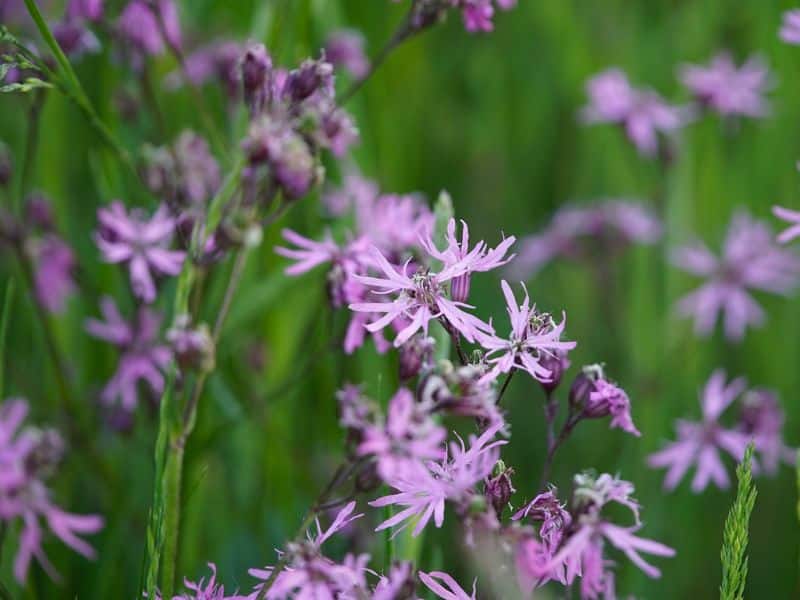
Dwarf ragged robin (Lychinis flos-cuculi), also known as dwarf crow flower or dwarf cuckoo flower, is a very charming wildflower to grow next to forest grass because it will add lots of color with its raggedy pink flowers.
This evergreen plant is a great ground cover for your garden bed because it will keep the soil cool and act as a living mulch to nourish the other plants in your garden.
Dwarf ragged robin grows well in partial shade and must be established in well-drained soil that is kept moist.
These flowers look their absolute best if mass-planted all over a garden bed. When they bloom, they will form bushy clumps of up to 14 inches tall. This is tall enough to conceal the dying foliage of forest grass during the cooler months but short enough to allow the hakonechloa macra Hakone grass to stand out during its growing season.
Zealand Hair Sedge
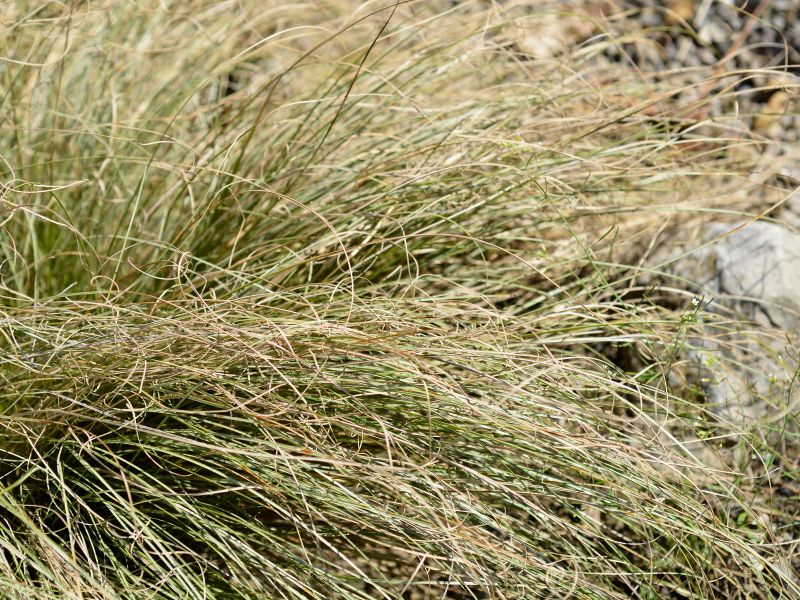
Zealand hair sedge (Carex comans), also known as mop-headed sedge or New Zealand hairy sedge, is a good option for gardeners who love to pair various ornamental types of grass in the same garden bed.
These Japanese forest grass companion plants will add a lot of texture to your garden because they produce weeping clumps of leaves that look like the hairs on a mop. Mop-head sedge is very useful as a border plant or garden filler but won’t add too much color since it produces non-showy flower stalks that are insignificant.
The clump-forming perennial will grow well in full sun or partial shade but should be developed in moist soil rich in organic materials. With its attractive leaves, this plant is drought-tolerant in its mature stage, but it will still grow well in wet conditions.
Gardeners love to grow this evergreen plant alongside forest grass to emphasize the difference in the leaf blades and their color. Growing them in the same garden bed will also help keep your garden nice and full during winter.
Black Mondo Grass

Ornamental grass lovers can consider pairing black mondo grass (Ophiopogon planiscapus), also known as mondo grass, with Japanese forest grass.
With its black leaves, this grass variety will form a lovely contrast with the vivid yellow-toned leaves of forest grass. This pairing will also look well in other seasons as the dense mounds of forest grass transition into golden, coppery orange colors.
This hardy plant species is an excellent garden filler and very useful as a border plant. It will also produce snow-white bell-shaped flowers during summer, making your garden look cheerful.
Mondo grass grows well in full sun to deep shade gardens. They can be established in any soil as long as it is nutrient-rich. This turf species is exceptionally tough and easy to care for, although it, like wild grass, requires frequent watering.
Because it only grows to 8 inches tall, this plant species should be planted in the front of your garden bed, whereas wild grass grows to 18 inches tall. You can also plant Japanese forest grass in the center of a round container with mondo grass to create a showy grass display.
Holly Fern
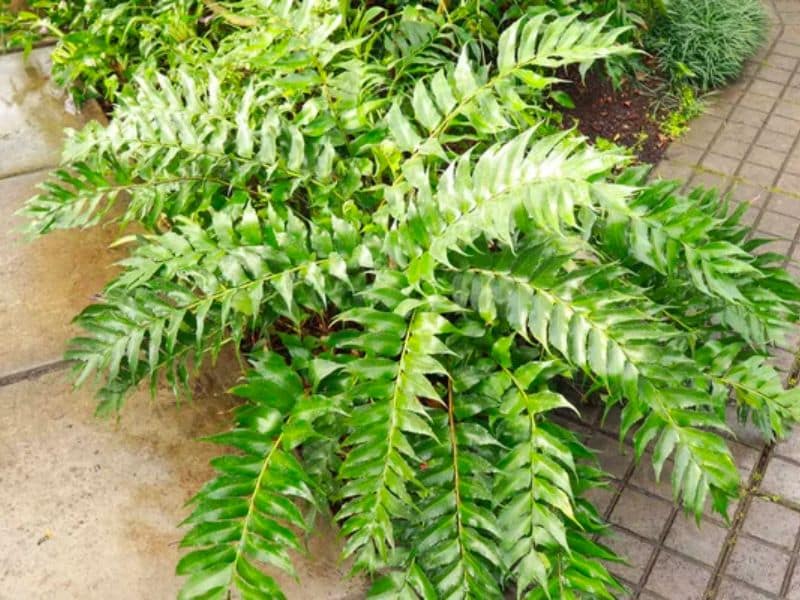
If you want to add plenty of texture to your garden bed or maintain your garden lovely and full over the winter, Holly fern (Cyrtomium falcatum) is an excellent companion plant to consider. The deep green leaves will also create a striking backdrop for your Japanese forest grass.
The evergreen perennial is very functional in woodland areas and can be used as a border plant or ground cover all over your garden bed.
Holly ferns can be grown in the ground or containers. This shade-loving perennial can be established in light to deep shade areas in well-drained soil that are kept moist.
The lush foliage can grow up to 2 feet tall and, as such, should be established in the back of your garden so you can still see the forest grass with ease.
Daylily
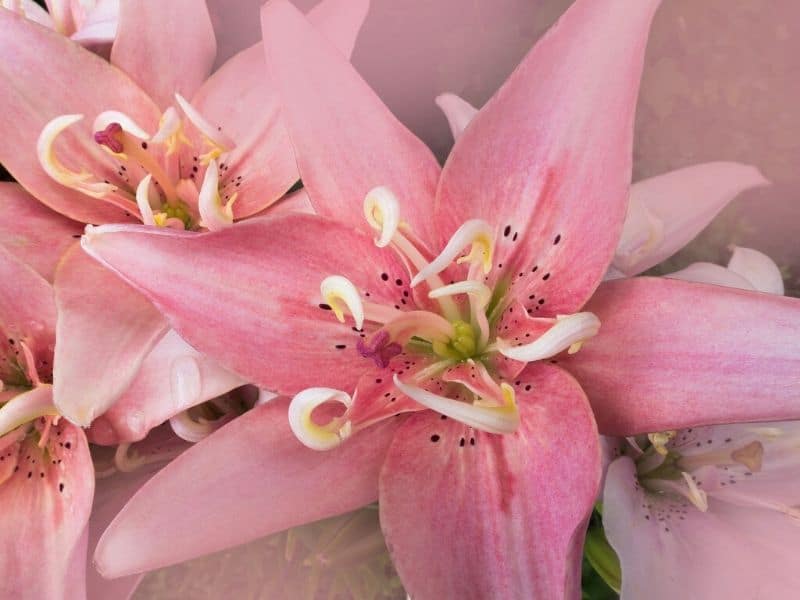
Daylilies (Hemerocallis) are a great plant species to consider if you want to add lots of color to your garden bed. This is because the daylily produces masses of showy flowers from mid-to-late summer. The most common varieties of daylily are the yellow and orange varieties. However, These flowers come in many hues, such as whites, pastels, pinks, purples, and true blue.
Different varieties can also have other growing habits. Some are evergreen, some dormant during winter, and some types produce semi-evergreen foliage.
These florals can grow well in full sun to semi-shaded positions but might produce fewer flowers if established in deep shade. The flowers need to be grown in well-drained soil, and they can be water-wise but should also grow well in moist soils.
Daylilies can grow rather tall, with a maximum height of up to four feet tall. Since forest grass only grows 18 inches tall, it is best to establish them in the front with your daylilies in the back. The golden foliage of your forest grass will add quite a bit of color to the dark green foliage of your daylilies.
Begonia
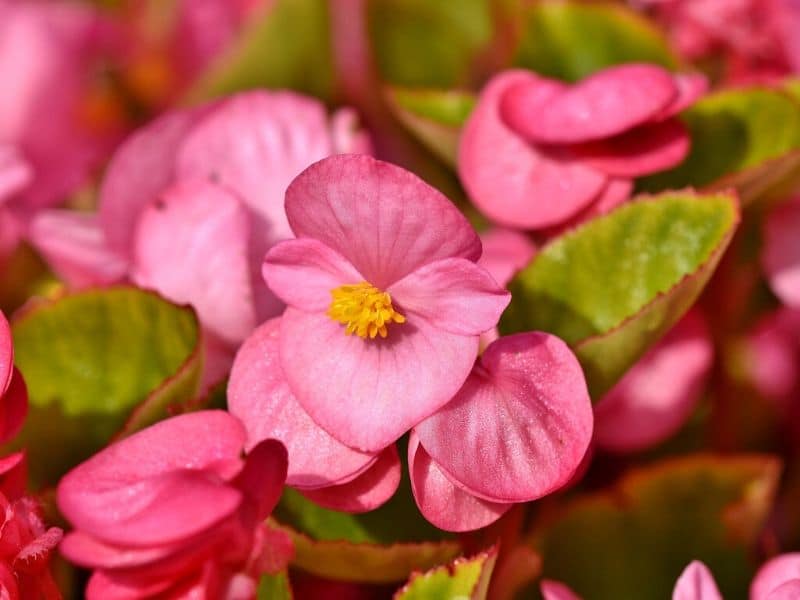
Begonias (Begonia) are great companion plants to grow with Japanese forest grass if you want to add lots of color to your garden bed or containers. There are thousands of different species of this evergreen flower, and they come in just about every color imaginable, including varieties with blue-green leaves and some with double blooms like begonia semperflorense, a double-flowered little beauty that forms striking rose-like flowers.
Begonias are favorites in shady gardens because they prefer dappled shade and grow well in moist soils with lots of organic matter.
When selecting begonia varieties to pair with Japanese forest plants, research the growing height of your begonia variety. Some types will stay short, just 8 inches tall, while others can grow up to 2 feet tall.
A bush or two of vibrant begonias with dark green leaves will look charming next to a bright yellow or lime green plant-like forest grass, especially when your showy begonias are in full bloom.
Hostas
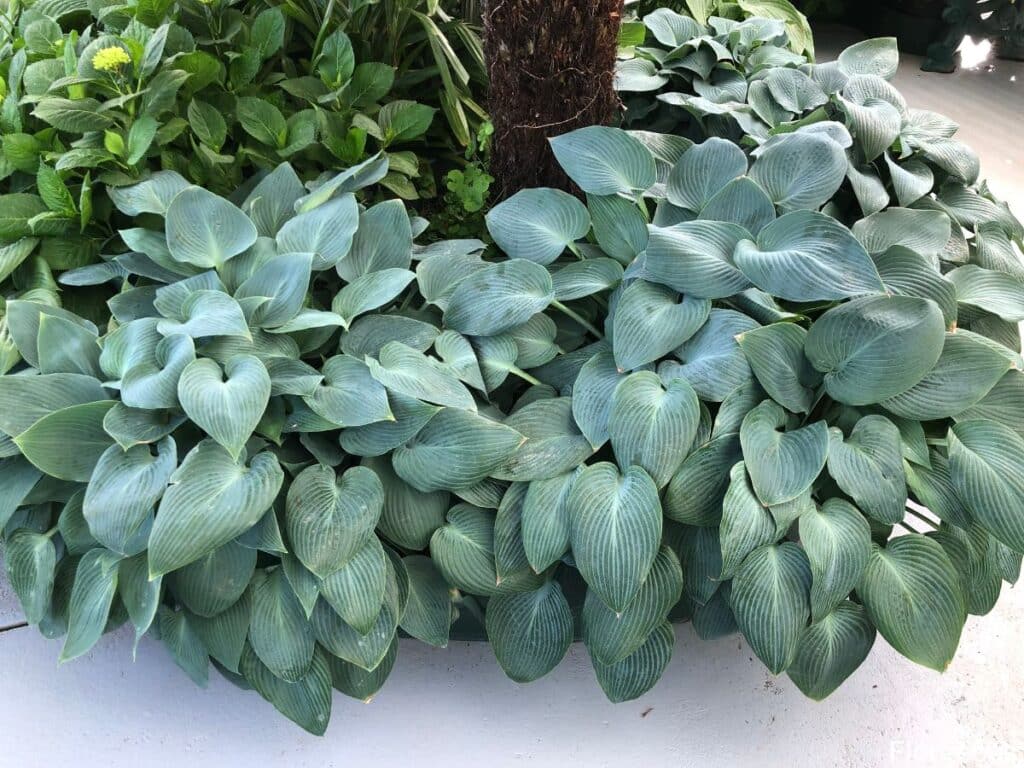
Hostas (Hosta), or plantain lilies, are every gardener’s dream because they are so easy to care for and add lots of color and vibrancy to your garden.
Although these bushy plants produce blooms on towering spikes, they are usually grown for their foliage. The leaf colors of this plant vary from dark green to lime green, with vibrantly striped creamy white borders on all the leaves.
This colorful leaves will provide a splash of color to your garden, it’s a great filler plant to keep your garden looking full, and hostas make excellent border plants. Hostas thrive in light to full shade. They also thrive in nutrient-rich soil that drains well yet is maintained wet.
They can withstand drought but prefer to be kept wet. Plantain lilies look best when planted in masses across the landscape. A couple of clumps of Japanese forest grass in the front of your garden beds may lend texture and beauty to a hosta garden.
Coleus
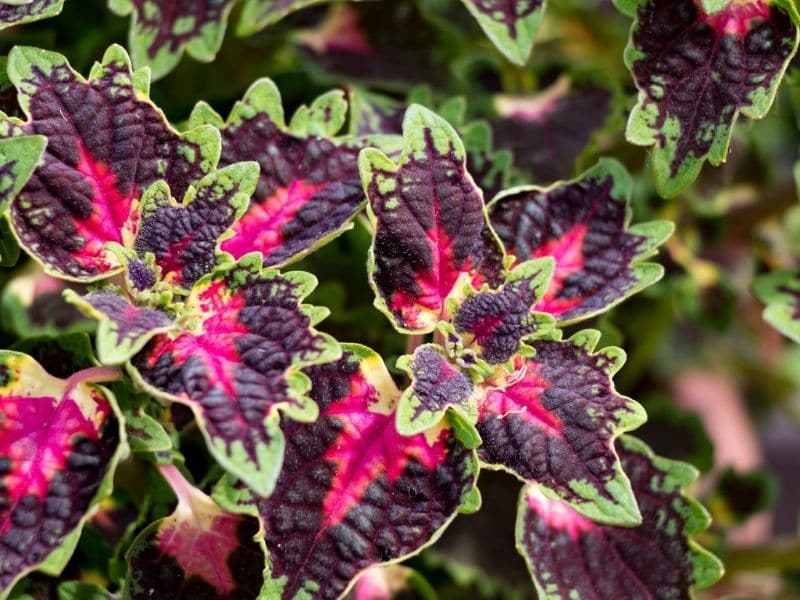
Coleus (Coleus scutellarioides) is another good shrub to grow next to Japanese forest grass because it will add lots of color to your garden bed.
There are many different varieties of coleus. The foliage colors can range from bright lime green with red centers to dark purple with vivid pink centers. These vibrant leaf colors will look striking if you pair them with a grassy plant species like Hakone grass.
These evergreen perennials will also keep your garden vibrant and full even in winter when the Japanese forest grass dies and becomes dormant for the colder season.
Coleus plants grow well in shade gardens and flourish in the same moist yet well-drained soil that forest grass requires.
You can grow coleus shrubs in bushes behind or beside your Japanese forest grass and keep these shrubs trimmed so they won’t overpower your garden. Many gardeners also love to pair coleus and Japanese forest grass in containers because coleus is a terrific filler plant, while the forest grass will act as a thriller with its fountain effect.
Columbine Flowers
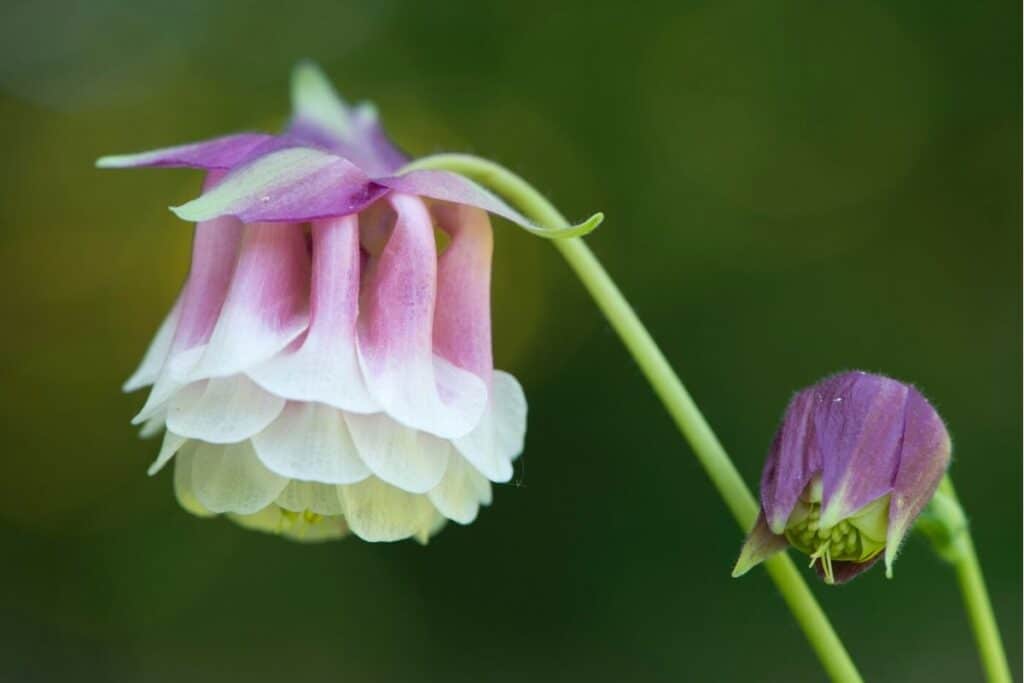
Columbine (Aquilegia) flowers are also great Japanese forest grass companion plants because these delicate yet vibrant flowers add lots of color to your garden bed.
There are over 780 different species of columbine flowers, and they can greatly range in color. The flowers appear in early spring and include hues like purple, yellow, pink, and blue in various shades, and some varieties also produce mixed-colored blooms.
The delicate green leaves of columbine flowers will add lots of texture to your garden, while the showy but small flowers will look striking next to a bright lime green foliage variety like Japanese forest grass.
Columbine flowers grow well in free-draining soil that is kept moist. They also prefer semi-shade areas like the edge of woodland gardens.
This accent plant can grow up to 30 inches tall and look its absolute best if it is mass planted around Japanese forest grass. If you want to create an especially charming display in your garden, consider pairing a vivid dark purple or bright blue flowering species with forest grass. This combination of colors will create lots of contrast.
What NOT to Plant with Japanese Forest Grass
Japanese forest grass is a shade-loving plant that can easily die if the plant’s roots become too dry. You can pair this plant with various species that can grow in shaded areas with lots of humidity and moisture. Japanese forest grass, on the other hand, will perish if planted in full sun or in extremely dry conditions.
Here’s a list of some of the worst companion plants for a Hakone grass garden bed.
Sun-Dependent Ornamental Grasses
Most ornamental grasses require lots of direct sunlight to flourish. It is best not to grow this plant species with sun-loving grasses like blue fescue grass, Karl Foerster grass, or feather reed grass next to your japanese forest grass. If these plants are established in shady and moist areas, they will be prone to root rot and their growth can be stunted.
Sun Loving Flower Plants
Sun-dependent blooming plants such as lavender, sage, bee balm, and coneflowers will not thrive in shady locations since they are prone to powdery mildew in these humid circumstances. These plants also won’t produce any flowers if they are deprived of direct sunlight.
Drought Tolerant Plants
Drought-tolerant plant species are prone to develop root rot or powdery mildew if they are grown in a shady spot. On the other hand, japanese forest grass will quickly die if the roots become too dry. It is best to avoid growing drought-tolerant plant species like lavender next to your beautiful Hakone grass.
Final Thoughts
Japanese forest grass can be paired with black mondo grass, daylilies, holly fern, mop-headed sedge, ragged robins, coral bells, plantain lilies, columbine flowers, and many other plants.
We hope this guide made finding some good companion plants to include in your garden bed easier so your fountain grass can make heads turn.
See more:
Image by photohampster – nahhan/depositphotos

